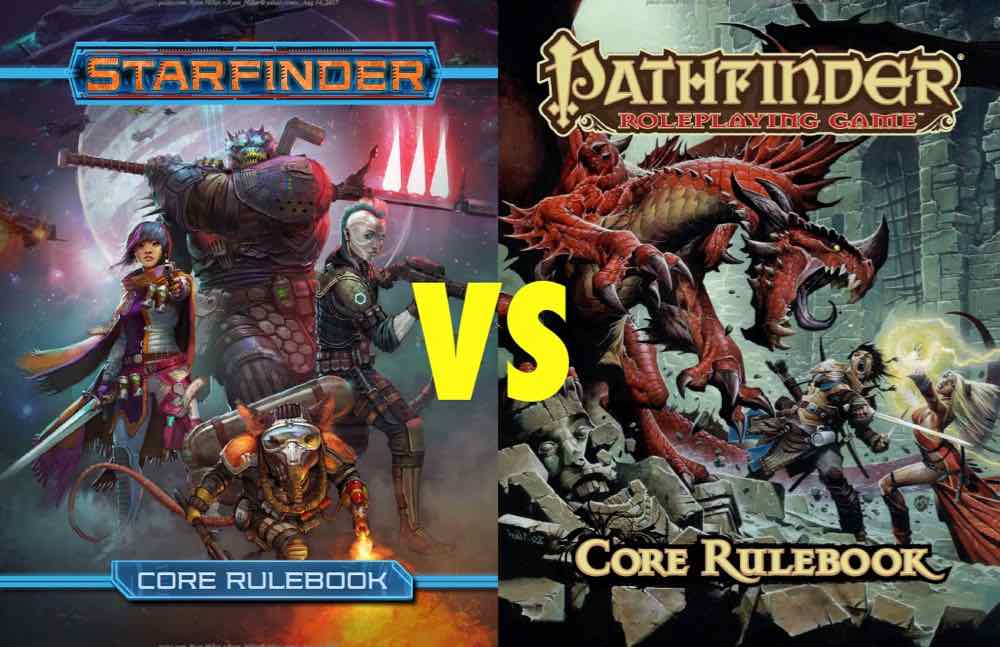 Starfinder, the intriguing new roleplaying game released at GenCon 50, is obviously born of Paizo’s experience with the enormously successful and ever-so awesome Pathfinder Roleplaying Game. Some level of compatibility between the systems was always stated as a goal, with an emphasis on making sure monsters from Pathfinder could easily be brought into the science-fantasy themed Starfinder. At the same time, this is Paizo’s chance to break free from compatibility with D&D 3.5 which Pathfinder evolved from. Given Paizo’s opportunity to streamline and improve the system, let’s find out what some of the main differences are.
Starfinder, the intriguing new roleplaying game released at GenCon 50, is obviously born of Paizo’s experience with the enormously successful and ever-so awesome Pathfinder Roleplaying Game. Some level of compatibility between the systems was always stated as a goal, with an emphasis on making sure monsters from Pathfinder could easily be brought into the science-fantasy themed Starfinder. At the same time, this is Paizo’s chance to break free from compatibility with D&D 3.5 which Pathfinder evolved from. Given Paizo’s opportunity to streamline and improve the system, let’s find out what some of the main differences are.
Interested in an overview of the the Starfinder Core Rulebook? I reviewed this awesome new game last week in Explore the Galaxy With the ‘Starfinder RPG,’ Sold Out at GenCon!
Okay, so what about the differences? The Paizo design team did an excellent job reducing the complexity of Pathfinder while keeping the best parts of the game, such as deep and engaging setting, and endless character creation options. In The Drift podcast they quoted Publisher Eric Mona of Paizo saying that if Pathfinder is a ten in complexity (and it wonderfully is!) that Starfinder is a six. I think this puts Starfinder somewhere between D&D 5e and Pathfinder/D&D 3.5. All have their merits, and their issues.
In short though, if you know how to play Pathfinder, you know how to play Starfinder. It’s a D20 system. It has strength, dexterity, constitution, intelligence, wisdom, and charisma with the same modifiers. It has fortitude, reflex, and will saves. It has Skills (with some remapping), initiative, rounds for combat, and many more similarities. So, what are the big differences in the mechanics of the game? What will the experienced Pathfinder player be surprised by?
1. Point-buy Mechanic: The way players assign their character’s ability scores has changed. Ability scores, strength, dexterity, constitution, intelligence, wisdom, and charisma, all start at 10. Then the player assigns any racial bonus. This raises some scores by two and may drop some scores by 2. Next the player chooses a theme that will also provide a bonus of +1 to one ability. At this point the player can add up to 10 points on a one-to-one basis to their ability scores. No score is allowed to be above 18, and no score should be below 8, and this just for racial reasons. The Core Rulebook states that you can, for roleplaying reasons, drop a score lower than 8, but reducing any score does not give you extra points to assign.
2. Ability Advancement: Instead of getting one point to assign to one ability score (strength, dexterity, etc.) every four levels like in Pathfinder, every five levels a player can upgrade four ability scores. If the current score is 16 or less, you get to add 2 points, and if the ability is 17 or more you can add one point. For instance, if a character had a strength, dexterity, constitution, intelligence, wisdom, charisma stat array of 18, 14, 11, 10, 10, 10, and at 5th level decided to boost strength, dexterity, intelligence, and charisma the new array would be 19, 16, 11, 12, 10, 12. While characters won’t have super high stats at first level, by the later levels they’ll be pretty boosted! If a player was trying to boost four stats as high as possible, by 20th level their stat array, before magic or technology boosting if available, could be, 22, 21, 18, 18, 10, 8. Whereas in Pathfinder you may start with higher scores (20, 15, 10, 10, 10, 8), but you’d have just five points through level 20 to assign to your abilities. While that could result in a 25 in one ability with no changes to the rest, let’s max our highest at 22 to compare arrays, this would result in something like 22, 18, 10, 10, 10, 8, not nearly as good as the Starfinder array.
3. Theme: In addition to race, class, and potential archetypes, a new selection during character creation is theme. A theme represents a “core aspect” of your character’s background and includes such choices as Ace Pilot, Bounty Hunter, Scholar, and Mercenary. In addition to flavor, a theme slightly boosts one ability score, aids some skill checks, and provides other bonuses at various levels. Starfinder has no traits like Pathfinder does.

4. Hit Points, Stamina Points, Resolve Points, Injury, and Death: The most noticeable difference in character generation is with Hit Points. Pathfinder’s Hit Points have now split into Hit Point, Stamina Points, and a new mechanic, Resolve Points, are pools of points that can be used for special actions.
- Hit Points measure how healthy you are. Loss of Hit Points represents actual physical injuries. When Hit Points reach 0, you are dying. Your starting Hit Points are determined by your race and class. As you gain levels your class determines how many more Hit Points you get each level. High constitution does not boost Hit Points. You can regain some Hit Points and all of your Stamina Points after 8 full hours of rest.
- Stamina Points measure your readiness and energy. Stamina Points are easier to get back. All damage is applied to Stamina Points first. Stamina Points are your ability to “shake off a punch.” You can fully replenish Stamina Points by spending one Resolve Point and taking a 10 minute rest. Stamina Points are determined by your constitution bonus and your class for first and all subsequent levels.
- Resolve Points measure how much grit and luck your character has. In addition to being used for healing as mentioned above, Resolve Points can be spent on various class abilities much like how in Pathfinder the Gunslinger has Grit Points. You determine your number of Resolve Points by taking half of the character’s current level (minimum 1) and adding the modifier of the key ability score of the character’s class. A character is going to start at first level with 1-5 Resolve Points. Resolve Points are fully replenished after 8 hours of rest.
- Dying: When your Hit Points reach zero, you fall unconscious and are dying. You lose one resolve point each round unless you are stabilized. If your Resolve Points are at zero and anything would cause you to lose another Resolve Point, you’re dead. If you are dying, you can stabilize by spending one-quarter your maximum Resolve Points. If you are stable but unconscious, you can spend one resolve point to heal one Hit Point and get back in the fight (but with just one hit point!). If any single attack takes you to negative your maximum Hit Points, you die out-right. A creature can also be stabilized with a Heal check, as well as technological and magical means. This is a big difference from Pathfinder where negative con kills you. In earlier levels when Hit Points are less than your typical constitution ability, Starfinder will be a little deadlier from single, lucky attacks, but at all levels after about third, a single hit on a weakened character is going to be much less likely to out-right kill a person. Also, with resolve, a Starfinder character can possibly save themselves by spending some resolve. In Pathfinder you’re counting on rolling well to stabilize, or someone else to heal you.
This system creates a mindset where we’re going to be much more careful when we start eating into Hit Points. While “hits” are taking down your Stamina Points, they’re really the effect of the character avoiding the hit with luck, or strain. So long as it’s just Stamina lost in a fight, it’s easy to rest, pop a Resolve Point, and be at 100%. The second we start losing Hit Points though, you’re starting to stare down death himself. The ability to pop some Resolve Points and stabilize, as well as actually heal a point, give the players more options. They don’t even need to count on a dedicated healer. One of the goals of the game design was to not require any specific set of classes in the game. In some of their play testing, they played with a whole group of soldiers to see if they could survive the scenarios.
5. Armor Class: Pathfinder’s Armor Class (AC), Touch AC, and Flat-footed AC are replaced with Energy Armor Class (EAC), Kinetic Armor Class (KAC), and a condition. EAC is target for attacks that deal some type of energy damage such as electricity, fire, or cold. KAC is targeted for attacks that deal damage from impact such as, bludgeoning, piercing, slashing–kinetic attacks. Armor provides separate bonuses for EAC and KAC. Whenever a character is flat-footed, such as when they have not yet acted in a round, you take a -2 to AC and cannot take Reaction actions (see below). That’s really all there is to say about that.

6. Equipment levels: All equipment in Starfinder has levels. A 3rd level character should have roughly 3rd level gear. It costs progressively more and is also progressively more powerful. I believe it will still be necessary to continually upgrade your gear to keep up with the power-curve, just like the math of Pathfinder assumes you’ll be getting higher bonus weapons, armor, and other magic items that boost your stats and saving throws. Interestingly, higher level weapons provide better damage, but not a better chance to hit. You’re just as likely to hit with that level one laser pistol as a level 20 laser pistol. You can also add fusions to weapons. These are essentially magical enhancements such as bleeding, corrosive, and holy.

7. Two Worn Magic Items: While in Pathfinder you have slots, each of which can typically have one magic item–head slot, neck slot, hands, belt, etc., in Starfinder you can only have two worn magic items such as rings, cloaks, amulets, and gloves–“beyond that, the magical fields start to interfere with each other.” Additionally you can only wear one of any type such as a cloak or amulet, except for rings which you can have two of. This limit applies to worn items, not to armor upgrades, held items, weapon fusions, augmentations, magic armor, consumables, or other forms of magic. So really, while only allowing two worn magic items seems to be a big change, you can still have magic weapons, armor, and potions.
8. Spells Cap at 6th Level: This is not really a change to the mechanics of the game but rather to available classes, and will be significant to someone who really wants to play a full-caster, able to cast physics-bending 9th level spells. Currently the spell casting classes cap out at 6th level spells. There is nothing preventing Paizo from introducing full-casters at a later time, and with them, higher level spells. The intent here is that in Starfinder with technology doing so much and becoming so prevalent, magic has stepped back. This does not really have much impact until 13th level, when casters see their first 7th level spells in Pathfinder. (Really, in the AD&D days, someone needed to look up level in a thesaurus!)
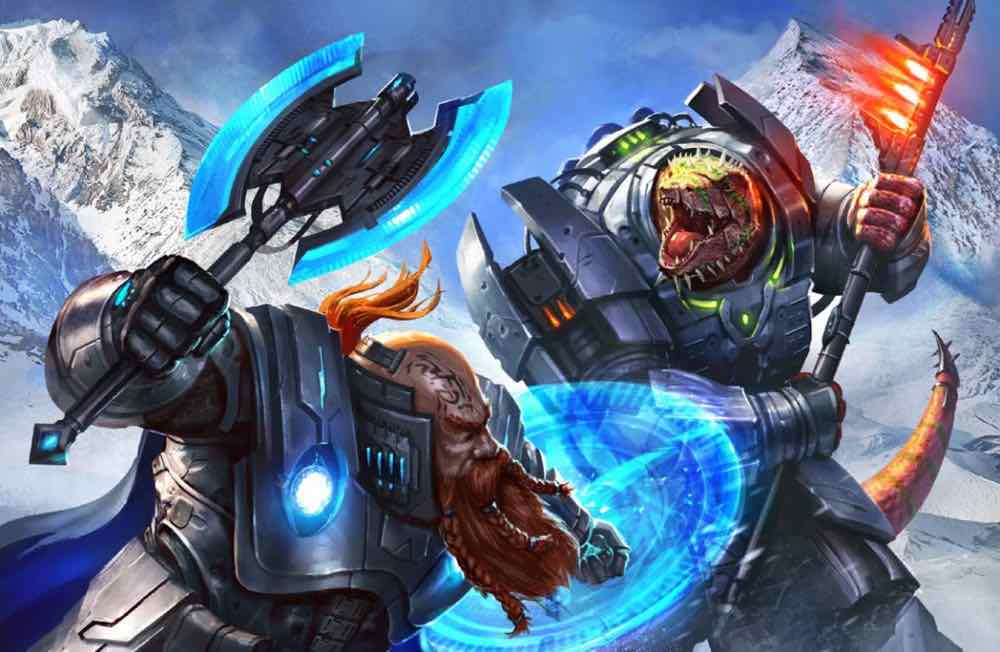
9. Action Economy: This is another big one. In combat, a Starfinder player has two primary choices each round.
- Take one Swift, one Move, and one Standard Action: The Standard can instead be a Move or a Swift. The Move Action can be a Swift.
- Perform a Full-Action.
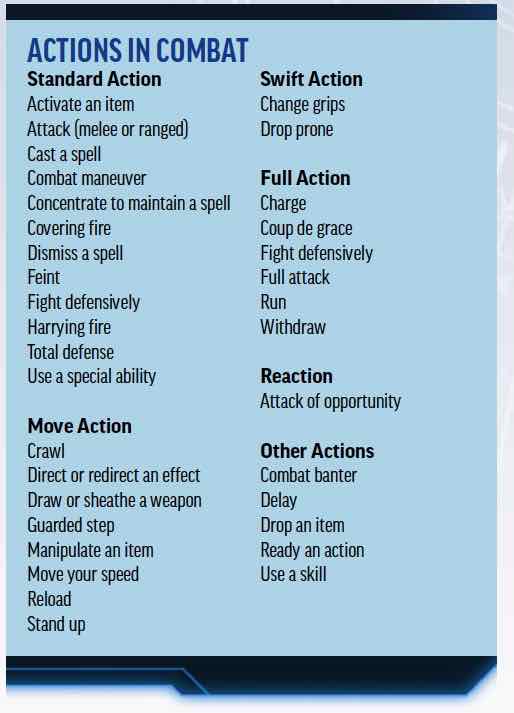
There is no 5-foot step like in Pathfinder. To avoid an attack of opportunity while moving you can take a Guarded-Step (which is 5′) as a Move Action. Since this is a Move Action it cannot be done if you perform a Full-Action.
Most Free Actions from Pathfinder are now Swift Actions. Combat Banter and dropping an item are still “free actions,” or rather in Starfinder, things you can do without spending one of your actions.
Last, characters can take one Reaction. The primary Reaction is an Attack of Opportunity taken as a response to a foe moving out of a threatened square, making a ranged attack, or casting a spell.
The change to not allow Swift Actions with a Full-Action would be devastating in Pathfinder to a swift-action dependent magus or war priest, but in Starfinder Swift Actions are not common.
This is definitely a simpler system. The main thing I’m curious about what the loss of the 5-foot step will do to in-combat movement, when players cannot move at all if they take a full-action.
10. No Iterative Attacks: There are no iterative attacks like in Pathfinder. Everyone of every class gets one attack per round, or, as a full-action they can choose to take two attacks, each with a -4 to hit. There’s no difference between swinging your two-handed sword twice, discharging your pistol twice, or if you’re using two separate weapons–all equate to two attacks at -4 to hit for each attack. Some weapons are unwieldy and cannot be used twice in a round. There is no difference for being a two-fisted fighter.
11. Critical Hits: Critical hits no longer need to be confirmed. If you roll a 20, and the total roll would be a hit versus the appropriate armor class, then you get a crit. A critical hit gives you double damage including all usual bonuses and bonuses from special abilities (trick attack damage is doubled! In Pathfinder, some types of damage, like a rogues sneak-attack damage, is not doubled.). Some weapons have additional critical effects. While it’s a little more realistic to have to confirm a critical, there’s nothing more disappointing as a player (or a GM) than rolling a nat-20 on the die and then missing the confirmation.
12. Feats: While there’s no mechanical difference in how feats work, I want to mention this because it is a difference in design philosophy that could result in more varied characters. One of the designers said that their intent with feats was to make sure there were no must-have feats–one that everyone would always take, like point-blank is on every Pathfinder archer’s feat list. I will have to confirm this through play and building characters for fun!
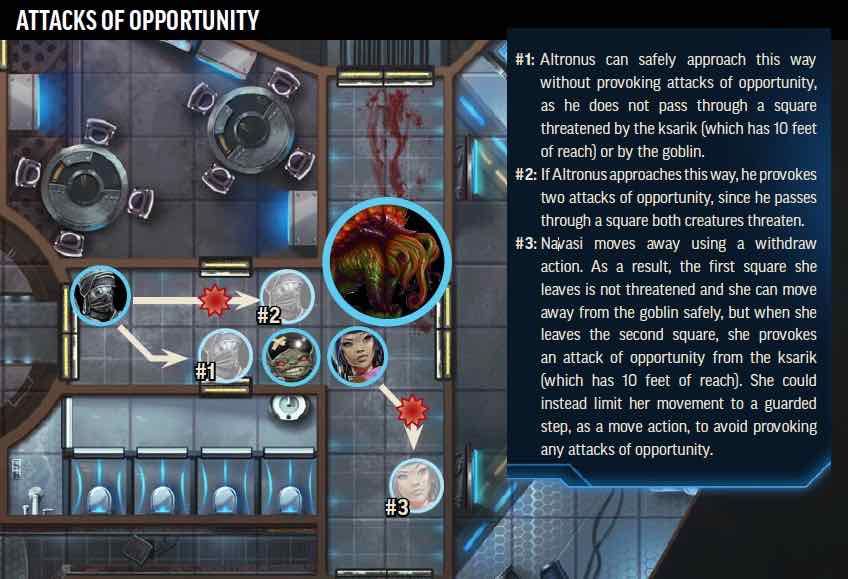
13. Attacks of Opportunity: Only three things trigger an Attack of Opportunity (AOO)–moving out of a threatened square, taking a ranged shot from a threatened square, casting a spell from a threatened square. A big change for spellcasters is that they can no longer cast defensively. If you cast when an enemy threatens you, the enemy gets an AOO. If they hit you, you lose your spell. There are some range-touch spells that do not trigger an AOO even if cast from a threatened square just like in Pathfinder.
14. Combat Maneuvers: Pathfinder’s CMD and CMB are gone. To perform a combat maneuver, you just roll a to-hit roll versus KAC +8. Also, as just mentioned, combat maneuvers, like grappling and tripping, don’t trigger an attack of opportunity. Grappling no longer requires a flow chart–it is much more succinct and clearly described in just four paragraphs. Since combat maneuvers don’t trigger AOOs, hopefully we’ll see them more frequently spicing up combat!
15. Starships! Starfinder has starships and we get to start playing with them at level 1! The ships feel with, and are essentially, another character in the game. I covered them in detail in my prior review, Explore the Galaxy With the ‘Starfinder RPG,’ Sold Out at GenCon!
Those are the big ones I remember from reading the 500+ page volume. Another significant change is in monster stat blocks and the designing of monsters, but I’ll detail that when the associated rules are released in October with Alien Archive which will include, “A robust NPC-creation system to let Game Masters build any aliens or creatures they can imagine.” At PaizoCon the designers discussed how they wanted to allow a game master to quickly get the guts of a balanced creature generated, letting the game master focus on the interesting abilities that make the new creature special.
Other than the Hit Point change, I think that in general these changes make for a significantly simpler system. The introduction of Stamina and Resolve Points, while having more moving parts to track, give us some cool capabilities we did not have before, like fully healing Stamina after a short rest. I love having many options each round, and having cool but limited special abilities that I have to agonize over using or not. Giving everyone Resolve Points, like Gunslingers have grit, offers this great mechanic to all characters, allowing them to have access to cool special abilities, that they have to dole out very carefully. I’m excited to try out all of these changes to get a better feel for them.
What do you think? What do you like or not like about these changes? Let us know in the comments.
Also, if I have any of this wrong, please comment so I can correct it. My hope with this article is to give people familiar with Pathfinder a feel for how Starfinder is different, and I want to get it right!
Disclosure: Paizo provided the ‘Starfinder Core Rulebook’ for review.


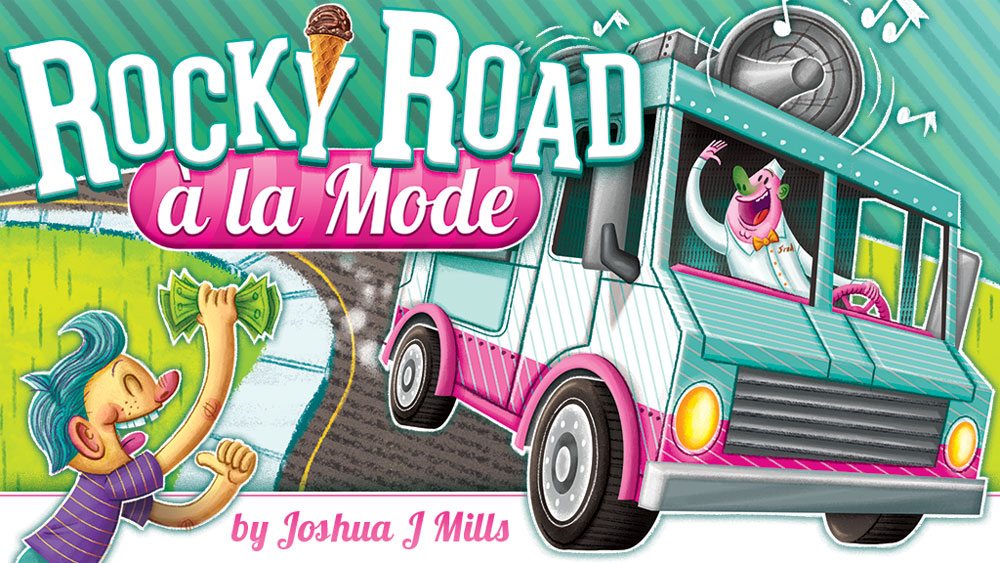

Interesting. Starfinder applies the Strength modifier to thrown weapon rolls instead of the Dexterity modifier.
That is interesting. I could maybe see this with something like an axe… but I don’t see strength affecting your accuracy with a grenade at close ranges. Maybe at longer ranges. A shuriken or throwing dagger though… I definitely see dex as the modifier.
Now that I have the Core Book, I can see that there is only a small number of thrown weapons aside from, obviously, grenades. Those are spears, starknives and Carbonedge shuriken, of which all make sense with Strength (yes, including shurikens. Don’t imagine the not-as-useful backhand throw popular from media, but the more commonly used overhead throw and you’ll see why Strength matters).
Grenades getting accuracy bonus with Strength still makes sense in my eyes, though. There aren’t graceful movements needed, just being able to judge the required distance and arc (which is perception-based) and the ability to cover said distance and arc, which requires a strong throwing arm.
You could make an argument that Strength doesn’t matter at close ranges, but with most explosions covering 15 ft. in all directions, that would be stupid, so we can safely ignore that problem *laughs*
Speaking of the confusion with the word “level”, Gygax actually addressed that in the 1e PHB. There’s a bit where he writes (paraphrased) “I considered using ‘rank’ for character power, ‘power’ for spell complexity, and ‘order’ for monsters, but everyone was used to using ‘level’ for everything so we kept that.”
So it’s been a known, and ignored, issue at least since 1978.
I went to look up the ‘Order of the Stick’ comic that discusses the confusion with level, and how the direction of the level (up or down) does not even consistently correlate with increasing/decreasing power. Then, at the end of the comic he says “didn’t even use a thesaurus”… so, I unwittingly utilized OOTS via my subconscious! All credit for the thesaurus joke should go to OOTS.
Relevant comic – http://www.giantitp.com/comics/oots0012.html
If you’ve never read Order of the Stick, you should. It’s awesome, and worth many read throughs! Here’s number one for your enjoyment. http://www.giantitp.com/comics/oots0001.html
Grappling innPathfinder is simple and does not require a flow chart.
You mean that grappling isn’t this? http://www.pfsprep.com/e107_files/public/1482694608_186_FT297_grappleflowchart_1.0.pdf
This is awkward… I found that to be a really helpful flowchart.
FYI – you actually can move and use a full-action, if you’re buffed by the Haste spell.
Yes… I’m sure there are spells and feats that will allow characters to deviate from what I discuss here. But, unlike Pathfinder, the standard is that there’s no movement with a full action. In Pathfinder you could take a 5′ step… which seams to me will result in somewhat different game play.
Thanks for your comment!
“While it’s a little more realistic to have to confirm a critical”
I’m a little curious on what basis do you consider confirming a critical to be realistic in a fantasy game.
I didn’t say it was realistic… I said it was MORE realistic. Obviously neither system is a perfect model of real life, but one system is a better model.
Requiring just a 20 means that a character crits 5% of the time regardless of their skill. On the other hand, requiring a confirm, by rolling the required to hit target, means a character of higher skill (that can hit with a 10+) is going to critical more often than the less skilled character that can only score a hit on a 19+.
It’s less realistic to say that a character that has a 50% chance of hitting is going to critically hit exactly as often as a person that has a 10% chance to even hit.
Is “confirming a critical” realistic? No… but it’s certainly closer to realism.
Thanks for your comment!
Thanks for this, succinct and informative. A big help for me coming from Pathfinder to get a handle on this new game. Well done!
Thanks! Enjoy the game!